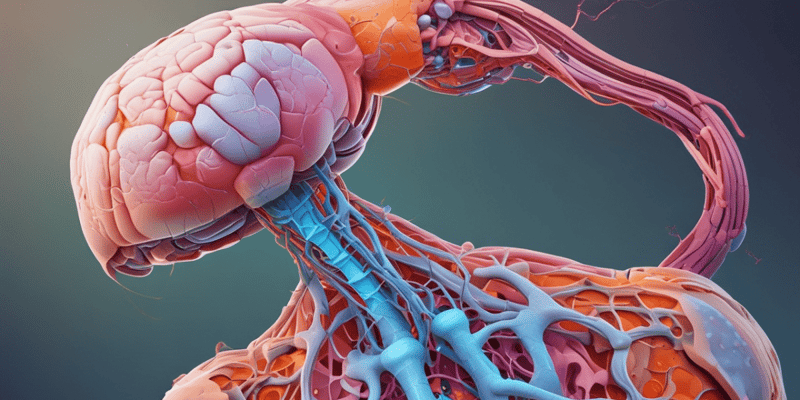44 Questions
What is the primary purpose of Chapter 2 in the ICD-10-CM?
To provide codes for most benign and all malignant neoplasms
When coding a neoplasm, what is the first step in determining the appropriate code?
Determine the histologic behavior of the neoplasm
How should a primary malignant neoplasm that overlaps two or more contiguous sites be coded?
Code to the subcategory/code .8 ('overlapping lesion')
How should multiple neoplasms of the same site that are not contiguous be coded?
Code each neoplasm separately
How should a malignant neoplasm of ectopic tissue be coded?
Code to the site of origin mentioned in the documentation
When coding a neoplasm, which source should be referenced first?
The histological term documented in the record
Which type of neoplasm may be found in the specific body system chapters of the ICD-10-CM, rather than in Chapter 2?
Benign neoplasms
What is the key factor that determines the appropriate code for a neoplasm?
The behavior of the neoplasm (benign, malignant, in-situ, etc.)
How should a malignant neoplasm that involves multiple contiguous sites be coded if the combination is specifically indexed elsewhere?
Code to the specific combination code
What should you refer to in the Alphabetic Index if the documentation indicates 'adenoma'?
Neoplasm, by site, benign
When referring to the Tabular List, what is important to verify when selecting a code from the table?
A more specific site code is not available
In which scenario would the primary malignancy NOT be designated as the principal/first-listed diagnosis?
Administration of chemotherapy or immunotherapy
Which condition is considered for management when the admission/encounter is solely for anemia associated with malignancy?
Anemia
In what case should the anemia code be sequenced first followed by appropriate codes for neoplasm and adverse effect?
Anemia associated with chemotherapy
What should be designated as the principal or first-listed diagnosis when the admission is for a complication from a surgical procedure?
Complication
When should dehydration be sequenced first followed by code(s) for the malignancy?
Management of dehydration due to malignancy
If a patient is admitted due to a primary neoplasm with metastasis and treatment is directed toward the secondary site only, what is designated as the principal diagnosis?
Secondary neoplasm
'Anemia associated with chemotherapy' should be sequenced ahead of which other condition?
Chemoimmunotherapy adverse effects
When a primary malignancy has been previously excised or eradicated, which code category should be used to indicate the former site?
Category Z85, Personal history of malignant neoplasm
If a patient admission/encounter is chiefly for the administration of chemotherapy, which code(s) should be assigned as the first-listed or principal diagnosis?
All of the above
If a patient receives more than one type of therapy (chemotherapy, immunotherapy, radiation therapy) during the same admission, how should the codes be assigned?
More than one of the Z51 codes may be assigned, in any sequence
When a patient is admitted for the insertion or implantation of radioactive elements (e.g., brachytherapy), what should be sequenced as the principal or first-listed diagnosis?
The appropriate code for the malignancy
If a patient is admitted for chemotherapy or radiation therapy and develops complications like uncontrolled nausea and vomiting, what should be the principal or first-listed diagnosis?
Z51.0, Encounter for antineoplastic radiation therapy, or Z51.11, Encounter for antineoplastic chemotherapy
When the reason for admission/encounter is to determine the extent of the malignancy or for a procedure like paracentesis or thoracentesis, what should be designated as the principal or first-listed diagnosis?
The primary malignancy or appropriate metastatic site
Can symptoms, signs, and ill-defined conditions listed in Chapter 18 be used to replace the malignancy as the principal or first-listed diagnosis?
No, regardless of the number of admissions or encounters for treatment of the neoplasm
When coding for an admission/encounter involving chemotherapy, immunotherapy, and radiation therapy, which of the following statements is true?
The malignancy for which the therapy is being administered should be assigned as a secondary diagnosis
If a patient is admitted for the insertion or implantation of radioactive elements (e.g., brachytherapy) and develops complications like uncontrolled nausea and vomiting, what should be the principal or first-listed diagnosis?
The appropriate code for the malignancy
Which code should be used to indicate the former site of a primary malignancy that has been excised or eradicated?
A code from category Z85, Personal history of malignant neoplasm
What is the code to be used for breast implant associated anaplastic large cell lymphoma (BIA-ALCL)?
C84.7A, Anaplastic large cell lymphoma, ALK-negative, breast
How should metastasis of diffuse large B-cell lymphoma to the lung, brain and left adrenal gland be coded?
Assign code C83.39, Diffuse large B-cell lymphoma, extranodal and solid organ sites
Which code should be used to indicate a personal history of leukemia?
Z85.6, Personal history of leukemia
What is the correct code to use for a malignant neoplasm of a transplanted organ?
Assign first the appropriate code from category T86.-, Complications of transplanted organs and tissue, followed by code C80.2, Malignant neoplasm associated with transplanted organ
Which code should be used to indicate a personal history of multiple myeloma?
Z85.79, Personal history of other malignant neoplasms of lymphoid, hematopoietic and related tissues
How should the documentation be coded if it is unclear whether leukemia has achieved remission?
The provider should be queried to determine the remission status
Which code should be used for follow-up care after completed treatment of a malignancy?
Assign a code from category Z08, Encounter for follow-up examination after completed treatment for malignant neoplasm
How should prophylactic organ removal for the prevention of malignancy be coded?
Assign a code from category Z40, Encounter for prophylactic surgery
Which of the following is true about coding a disseminated malignant neoplasm with an unspecified primary site?
Code C80.0 should be used when the patient has advanced metastatic disease and no known primary or secondary sites are specified.
When should the code C80.1, Malignant (primary) neoplasm, unspecified, be used?
When the primary site of a malignancy is unknown, and no secondary sites are specified.
When a patient has a malignant neoplasm complicating a pregnancy, how should the codes be sequenced?
The code from subcategory O9A.1- should be sequenced first, followed by the code for the type of neoplasm.
When an encounter is for management of a complication associated with a neoplasm, such as dehydration, how should the codes be sequenced?
The complication should be coded first, followed by the appropriate code(s) for the neoplasm.
How should the codes be sequenced when an encounter is for a pathological fracture due to a neoplasm?
A code from subcategory M84.5, Pathological fracture in neoplastic disease, should be sequenced first, followed by the code for the neoplasm.
If a patient has a primary malignancy that has been excised, but further treatment is directed to that site, how should the codes be sequenced?
The code for the current malignancy should be used until treatment is completed.
What should be done if the documentation is unclear about the status of multiple malignant tumors in the same organ?
The provider should be queried as to the status of each tumor so that the correct codes can be assigned.
How should the codes be sequenced when an encounter is for treatment of a secondary malignancy with metastasis?
The metastatic site(s) should be designated as the principal/first-listed diagnosis, and the primary malignancy should be coded as an additional code.
Study Notes
Neoplasms (C00-D49) General Guidelines
- Chapter 2 of the ICD-10-CM contains codes for most benign and all malignant neoplasms.
Primary Malignant Neoplasms Overlapping Site Boundaries
- A primary malignant neoplasm that overlaps two or more contiguous sites should be classified to the subcategory/code 8 ('overlapping lesion'), unless the combination is specifically indexed elsewhere.
Malignant Neoplasm of Ectopic Tissue
- Malignant neoplasms of ectopic tissue are to be coded to the site of origin mentioned (e.g., ectopic pancreatic malignant neoplasms involving the stomach are coded to malignant neoplasm of pancreas, unspecified).
Coding and Sequencing
- The neoplasm table in the Alphabetic Index should be referenced first to determine the proper code based on the type of neoplasm and the site.
- Select the proper column in the table that corresponds to the type of neoplasm.
- The Tabular List should then be referenced to verify that the correct code has been selected from the table and that a more specific site code does not exist.
Admission/Encounter for Treatment of Primary Site
- If the malignancy is chiefly responsible for occasioning the patient admission/encounter and treatment is directed at the primary site, designate the primary malignancy as the principal/first-listed diagnosis.
- Exception: if the administration of chemotherapy, immunotherapy, or external beam radiation therapy is chiefly responsible for occasioning the admission/encounter.
Admission/Encounter for Treatment of Secondary Site
- When a patient is admitted because of a primary neoplasm with metastasis and treatment is directed toward the secondary site only, the secondary neoplasm is designated as the principal diagnosis even though the primary malignancy is still present.
Coding and Sequencing of Complications
- Anemia associated with malignancy: code the malignancy as the principal diagnosis, followed by the code for anemia (e.g., D63.0, Anemia in neoplastic disease).
- Anemia associated with chemotherapy, immunotherapy, and radiation therapy: code the anemia first, followed by the code for the neoplasm and the adverse effect (e.g., T45.1X5-, Adverse effect of antineoplastic and immunosuppressive drugs).
Management of Dehydration due to Malignancy
- When the admission/encounter is for management of dehydration due to the malignancy, code the dehydration first, followed by the code(s) for the malignancy.
Treatment of a Complication Resulting from a Surgical Procedure
- Designate the complication as the principal or first-listed diagnosis if treatment is directed at resolving the complication.
Primary Malignancy Previously Excised
- When a primary malignancy has been previously excised or eradicated from its site and there is no further treatment directed to that site, a code from category Z85, Personal history of malignant neoplasm, should be used to indicate the former site of the malignancy.
Admissions/Encounters Involving Chemotherapy, Immunotherapy, and Radiation Therapy
- When the patient admission/encounter is chiefly for the administration of chemotherapy, immunotherapy, or external beam radiation therapy, assign code Z51.0, Encounter for antineoplastic radiation therapy, or Z51.11, Encounter for antineoplastic chemotherapy, or Z51.12, Encounter for antineoplastic immunotherapy as the first-listed or principal diagnosis.
Pain Control/Management
- See Section I.C.6 for information on coding admission/encounter for pain control/management.
Breast Implant Associated Anaplastic Large Cell Lymphoma (BIA-ALCL)
- Assign code C84.7A, Anaplastic large cell lymphoma, ALK-negative, breast, for BIA-ALCL.
Learn about the codes for benign and malignant neoplasms in Chapter 2 of ICD-10-CM. Understand how to properly code neoplasms based on their histologic behavior and identify any secondary metastatic sites. This quiz covers essential guidelines for coding neoplasms.
Make Your Own Quizzes and Flashcards
Convert your notes into interactive study material.
Get started for free



